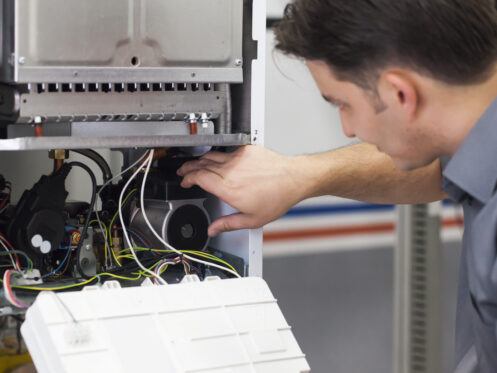In North America, furnaces stand out as a top choice for heating homes during colder months. Options include propane, natural gas, oil, and electric furnaces. Among these, natural gas and electric furnaces lead in popularity. While both produce heat, they operate differently. When considering a new furnace purchase, evaluating each type’s advantages and disadvantages is essential.
Choosing Between Gas and Electric Furnaces
Gas and electric furnaces differ in initial costs. Additionally, maintenance requirements vary between the two. Operating costs also differ, and selecting the appropriate unit size is crucial. Choosing a furnace that’s either too large or too small results in unnecessary expenses and discomfort in your home. To make an informed decision between gas and electric furnaces, consider the following factors.
Gas and electric furnaces come with different upfront costs. Each type of furnace demands distinct maintenance procedures. Evaluate the ongoing expenses associated with both gas and electric furnaces. Additionally, select a furnace size that aligns with your home’s heating needs to optimize efficiency and comfort.
By examining these factors, you can determine whether a gas or electric furnace best suits your home’s heating requirements and budget.
How Gas and Electric Furnaces Work
Both gas and electric furnaces operate as forced air heating systems. A thermostat acts as the unit’s control center, directing when to activate or deactivate based on the desired home temperature. When the room temperature drops below the set level, the thermostat prompts the furnace to start. Once the target temperature is achieved, the unit receives another signal to shut down.
In a gas furnace, the thermostat signal lights the pilot light within the main burner of the heat exchanger. The pilot light then triggers gas-fed burners, heating the air inside the heat exchanger. This heated air circulates throughout the house.
Conversely, an electric furnace uses electric ignition upon receiving a thermostat signal. This action activates electric heating elements within the furnace, similar to the filaments in a toaster. These elements heat up, and a blower then pushes the warmed air through the ductwork to heat the home.
Both types of furnaces pull in cool air through an intake vent, circulating it back to the furnace. Once the home reaches the desired temperature, the heating elements in the furnace deactivate. Subsequently, the fan disperses the remaining heated air before also shutting down.
Installation
Installing an electric or gas furnace is not a do-it-yourself job. Failure to install either apparatus properly can result in damaging the unit, damaging your home, and, in the worst case scenario, the loss of life. It is best to leave the work up to HVAC professionals.
Gas Furnace
One of the things that makes installing a gas furnace so challenging is the fact that you’re dealing with combustion elements and natural gas. During the installation process, technicians must perfectly seal the heat exchanger and other elements so that carbon monoxide does not leak from the system. HVAC technicians use specialized equipment, tools, sensors, and knowledge to install a gas furnace properly. Additionally, ventilation is key to the success of a gas furnace. The furnace needs to be able to blow off excess fumes outside of the home.
Electric Furnace
An electric furnace requires high-voltage electricity. Heavy-duty wiring is used to transfer high-voltage electricity from the electric box breaker to the furnace. Because of the levels of electricity used, most municipalities have stringent regulations on the installation process of these units.
Efficiency Levels
If you’re comparing between a gas and an electric furnace, an electric furnace is more efficient. Most electric furnaces have an annual fuel utilization efficiency (AFUE) Rating of 100%. With a gas furnace, ratings range from between 55% to 97%.
Energy efficiency is the percentage of energy the furnace turns into heat. It has nothing to do with how quickly the furnace can heat your home. With an electric furnace, almost all of the energy used by the unit is turned into heat. With a gas furnace, that number is going to vary based on factors like the type of unit you purchase and the amount of energy that gets lost through various parts of the heated air distribution system.
Gas furnaces do a better job at heating a space faster than electric furnaces, even though they are not as efficient. More efficient gas systems are understandably more expensive than their non-expensive counterparts. However, a good portion of the extra investment you make will be offset by the savings you get over the unit’s lifespan.
A gas furnace produces a hotter heat than what can be produced by electric coils. Natural gas is cheaper in most areas than electricity, making it the best option for colder climates. In a warmer climate that doesn’t require a lot of heating, many opt for an electrical furnace because it has a lower initial cost, requires less maintenance, and is financially better suited for many in areas with warmer winters.
Safety and Maintenance
Electric furnaces win this competition. They are easier to maintain than their gas counterparts and require less professional maintenance. Electrical units will have a burner that needs inspection or cleaning, but the overall system requires very little cleaning or maintenance. This means that electric furnaces are easier and less expensive to maintain when you look at the unit’s lifetime.
Gas furnaces do require constant maintenance by HVAC professionals. These units should be inspected and cleaned every year. During this check, the HVAC technician will ensure that the system is operating as it should and that there is no corrosion or condensation. They will also ensure that the unit is not giving out excess amounts of carbon monoxide.
How Long Do the Different Styles of HVAC Units Last?
If properly maintained, gas systems can last for 10 to 20 years. Electric systems can last between 20 to 30 years with proper maintenance.
The shorter lifespan of gas furnaces has a lot to do with the same reason why gas furnaces need more maintenance. The burner produces particles that build up inside the furnace. If these particles are not regularly cleaned, it can lead to premature system failure. Additionally, the heat exchanger and other working parts inside of the furnace run the risk of damage over time. Electric furnaces don’t have these issues, so they can work longer with minimal breakdowns.
Noise
Electric furnaces are quieter than their gas counterparts. This is because most electric furnaces have a very simple design and have little to no moving parts, burners, or vents. This does not mean that gas furnaces are noisy. But they do make a particular sound, especially when they start up.
Heating and Air Conditioning in Panama City Beach, Florida
At Paradise Home Services, we are committed to being the leading home service provider in our area. We proudly employ skilled HVAC technicians who do a quality job, providing energy efficiency, reliability, and affordability.
Our services include HVAC installation, maintenance, and repair. We install heat pumps and offer general plumbing, water heaters, hydrojetting, camera inspection, and tankless water heater inspection. Learn more about Paradise Home Services and see for yourself why our services are so highly sought after.


